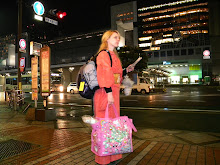
 Kyongju (or Gyeongju) is, almost inarguably, Korea's most famous historic town, containing such a large variety of significant cultural relics that the area is commonly referred to as "a museum without walls." Perhaps this is due to its location, sufficiently isolated from the devastation war and conquest brought to so much of Korea's architectural history.
Kyongju (or Gyeongju) is, almost inarguably, Korea's most famous historic town, containing such a large variety of significant cultural relics that the area is commonly referred to as "a museum without walls." Perhaps this is due to its location, sufficiently isolated from the devastation war and conquest brought to so much of Korea's architectural history.As a possible contradiction to my hypothesis of preservation, Kyongju was not always a sleepy little town of ruins; it was once the capital of the Silla empire, the dynasty that politically controlled Korea between the 7th to 9th century. The city itself, more than 2,000 years old, is now registered as a UNESCO world heritage site.

The Chomsongdae Observatory, an astronomical tower built in 647, is the oldest standing observatory in East Asia. It is constructed of 361 stones, which is equal to the number of days in a lunar year. The four square sides of this tower are precise in facing the four geographical directions. Some historians consider the possibility that this acted as a meridian for the Silla people.
A tiny cave in the middle of the mountains near Kyongju houses one of the world's loveliest Buddha statues. Made of white granite, it is considered a masterpiece in Asian artwork, but you can only see this image if you visit the Seokgulam Grotto because photos are forbidden.
An equally famous stop in Kyongju is Tumuli Park. This area of the city appears to be filled with perfectly-formed hills. In reality, these "hills" are tombs older than the pyramids of Egypt. When the tombs were excavated in the 1970s, they were to found to have jewelry and intricate weaponry inside them, as well as physical remnants of the deceased royal subjects. My favorite (is it macabre to claim a favorite tomb?) was the Chonmachong tomb. This dates from the 5th or early 6th century AD, and visitors are permitted to go inside it, ala Lara Croft.

Altogether, there are 155 royal mound tombs of the Silla dynasty, a treasure trove of history and rich ornamentation. These tombs are spread throughout the region so it is nearly impossible to see all of them in one day. The biggest tomb, at 80 x 120 meters, is a joint tomb (a "his" and "hers" burial plot, so to speak) called Hwangnam Daech Ong. It rests just behind a small lake.

Another famous lake in the area is Anapchi Lake in Wolsong. The garden islands of Anapchi Lake were originally designed by King Munmu as an ideal setting to hold parties and conferences. Usually, man-made lakes and islands seem too contrived to capture my imagination, but when the garden lake was made by royalty in 674, it lends it a greater appeal.

Here is the point where I confess: My visit Kyongju was as part of a tour. I usually hate tours both for the high pricing and for the general blandness that accompanies them, but this tour was remarkably cheap and, let's face it, convenient in dragging me from site to site on a bus. That is both the downside and upside to tours. They smooth out everything, so there is little to no adventure left, hence why I am only spouting facts and presenting pretty pictures from this trip, rather than writing about it as an adventure.
And up until this point of the trip, things were amazingly smooth, inspite of the "breakfast and dinner included" that consisted of the same dry bread and peanut butter for ALL the meals. Still, like I mentioned, the tour came at a very low cost, so I took the cheap breakfast with a grain of salt . . . and a grain of rice and several bowls of noodles at a restaurant down the street from our lodgings.

The only real hitch in the trip was during the last leg, where we were told about a beautiful Buddha, carved into the white rockface of a mountain centuries ago. It was "a masterpiece of late Silla period" and "a sight everyone in Korea must see."
So, even though some of the tour group stayed at the base of the mountain chatting and luxuriously sipping their too-sweet Korean coffee, I stretched out my weary limbs, cramped from the long bus ride, and began to ascend the trail. I would see the tour leader at various intervals. "Not much longer!" she'd cheer. "It's definitely worth it. I've seen it before," she called out from a temple half-way up the mountain, where she'd decided to end her hike, opting out of seeing the must-see Buddha a second time.
I continued the ascent, inspite of an "accident" where a cranky old adjushi used both hands to push me to the ground so he could step over me on a particularly narrow section of the trail. "That's rude, sir!" I yelled back at him, while scowling viciously from my unwanted dirt seat. "I don't care if you don't understand what I'm saying, you're rude!"
Most disappointingly, when I finally reached the Buddha, it was closed. The only "must see" quality about it was that it was, in fact, rather impressive that anyone could manage to close a statue carved into the side of a mountain. It was securely closed, too, so that even if a person tried to quietly sneak onto it for a closer look at the Buddha, she would get chased away. Hypothetically speaking, of course.
Here is the best view I got of the Buddha, obtained by using my zoom lens while balancing precariously on a rock head far above the actual sculpture.

Fortunately, they could not close the views.




No comments:
Post a Comment